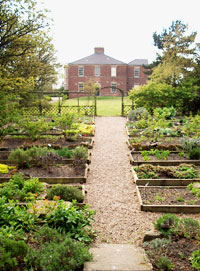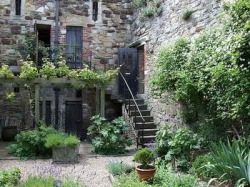The Monastic Garden

This is a list of herbaceous plants commonly grown during the Medieval period. Much of the information available concerning herbalism during this era is compiled from the writing of monks, where we find intimately recorded the nature and properties of a wide variety of herbs.
Following the example of St. Benedict and the religious trend of that period, many monasteries were built in wild and remote locations where the devout monk could be inspired by the beauty of nature and much removed from the temptations of city life. The isolated nature of these dwellings required their inhabitants to build an infrastructure which would produce most of life's necessities, and this revolved primarily around the garden. These legendary enclosed gardens produced not only food, being complete with fish ponds and extensive vegetable gardens, but also medicine and even dye for fabrics.
Herb gardens were often divided into a food garden and an infirmary garden, although the plants cultivated as medicines and salves were found in the salad bowl as well. Looking back on the history of herbs we can see that each one was ascribed a myriad of attributes. In these early times there was little distinction between a vegetable, medicinal and a poisonous plant. Herbs, shrubs, trees and all plant life were simply useful and a means to survival.
Although many of these plants are no longer prescribed by modern herbalists, many figure into both folk remedies and kitchen gardens, while some are grown simply for their beauty and rich history.
Following the example of St. Benedict and the religious trend of that period, many monasteries were built in wild and remote locations where the devout monk could be inspired by the beauty of nature and much removed from the temptations of city life. The isolated nature of these dwellings required their inhabitants to build an infrastructure which would produce most of life's necessities, and this revolved primarily around the garden. These legendary enclosed gardens produced not only food, being complete with fish ponds and extensive vegetable gardens, but also medicine and even dye for fabrics.
Herb gardens were often divided into a food garden and an infirmary garden, although the plants cultivated as medicines and salves were found in the salad bowl as well. Looking back on the history of herbs we can see that each one was ascribed a myriad of attributes. In these early times there was little distinction between a vegetable, medicinal and a poisonous plant. Herbs, shrubs, trees and all plant life were simply useful and a means to survival.
Although many of these plants are no longer prescribed by modern herbalists, many figure into both folk remedies and kitchen gardens, while some are grown simply for their beauty and rich history.
Gardens of the Modern Medievalists

The intriguing and magical history of herbs has continued to fascinate and inspire gardeners throughout the ages. While they remain shrouded in mystery, they are in fact some of the easiest plants to grow and care for. Once planted, these extremely hardy perennials will continue to raise their heads each spring, some of them even having the tenacity to flower in the snow.
While it takes careful planning to design a garden that pleases the eye, once it is thriving an herb garden is a continual source of food, flavor, medicine and tranquility.
Below are outlined some planting options for smaller garden designs, featuring lists of herbs that we have found complimentary.
While it takes careful planning to design a garden that pleases the eye, once it is thriving an herb garden is a continual source of food, flavor, medicine and tranquility.
Below are outlined some planting options for smaller garden designs, featuring lists of herbs that we have found complimentary.
Kitchen Garden
The culinary herbs on this list have proven themselves invaluable throughout the ages, for their health giving properties and the immense enrichment to the diet that they provide. For one who has never had a basic herb garden you will be continuously amazed and delighted by their tastiness and tenacity. Although every plant can benefit from a soil tailored to it's needs, these plants require little or no pampering, and whatever care you give them will be returned to you in astounding yields. We consider these herbs absolutely crucial additions to any garden.
Oregano, Marjoram, Thyme, Savory, Chives, Sage, Parsley, Bay Laurel, Cilantro, Chervil, Rosemary and Lovage.
Oregano, Marjoram, Thyme, Savory, Chives, Sage, Parsley, Bay Laurel, Cilantro, Chervil, Rosemary and Lovage.
Dessert Garden
In the simple life of a monk, food was one thing that was immensely celebrated. There is a common assumption that devout worshipers lived humbly on dry bread, but in truth they ate far better than the surrounding villagers, and sometimes even the royalty. It has been surmised that many people entered the orders simply to escape hunger. Dinners were said to be veritable feasts involving many courses, and featuring fresh fish, a wide variety of vegetables, the finest wines, ales and of course, dessert. Sweetmeats and all manner of pie and pastry played a large part in the medieval diet. Below is a list of edible flowers and sweet tasting herbs that complimented their dessert plates so well.
Melissa, Spearmint, Peppermint, Sweet Cicely, Licorice, Violets, Angelica, Rose, Fennel, Columbine, Strawberries.
Melissa, Spearmint, Peppermint, Sweet Cicely, Licorice, Violets, Angelica, Rose, Fennel, Columbine, Strawberries.
Friar Tuck's Garden
A garden specially tailored to the home brewer, all of these plants are valuable for many other attributes as well. Please note also that many of these plants are completely obsolete from modern brewing, some due to toxicity levels. Nevertheless many old recipes necessitate these plants, and the sheer availability of them demonstrates that perhaps the old brews have not been laid totally to rest.
Hops, Costmary, Sweet Woodruff, Wormwood, Mugwort, Henbane, Mint, Yarrow, Borage, Licorice and Black Elder.
Hops, Costmary, Sweet Woodruff, Wormwood, Mugwort, Henbane, Mint, Yarrow, Borage, Licorice and Black Elder.
Tea Garden
Any herbal tea lover knows that these plants have been enjoyed for centuries for their delicious aromatic qualities. As well being tasty and relaxing in the teacup, they are also a tremendous boost for the health and spirit. Not to belittle the common teabag, but having a variety of sweet, fresh herbs at one's fingertips is another experience altogether, and mixing sprigs and flowers of the below plants provides an endless assortment of sublime teas.
Peppermint, Spearmint, Mellisa, Borage, Chamomile, Chicory, Fennel, Anise Hyssop, Sweet Woodruff, Cowslip, Rose, Licorice.
Peppermint, Spearmint, Mellisa, Borage, Chamomile, Chicory, Fennel, Anise Hyssop, Sweet Woodruff, Cowslip, Rose, Licorice.
Medicine Garden
Given that much of Medieval herbalism is lost, outdated and simply not practiced, I've included a fairly short list of plants for a basic physician's garden. These are the primary herbs that figure into folk remedies of that era, and all are respected in the natural health field today for their healing properties. Whilst they may not single handedly cure the bubonic plague, this list includes treatments for burns, fevers, insomnia, cramps, coughs and more.
Horehound, Mint, Lemon balm, Feverfew, Mugwort, Chamomile, Lavender, Houseleek, Arnica, Valerian, Elecampane.
Horehound, Mint, Lemon balm, Feverfew, Mugwort, Chamomile, Lavender, Houseleek, Arnica, Valerian, Elecampane.
Perfume Garden
To appreciate the importance of the perfume in the early days of it's industry, we must remember that it was born before indoor plumbing, and that to most a latrine was a hole or bucket in their home. The luxury of bathing required a good deal of well water to be hauled, firewood to be collected, not to mention free time, of which the struggling peasants had very little. Consequently, the towns of Medieval Europe smelled terribly, and though perfume was something only a limited amount of people could afford, I am led to believe that those who could appreciated it immensely. The aromatic herbs below are are still used to inspire health, sensuality, joy, and are an olfactory delight to the gardener.
Lavender, Hyssop, Myrtle, Rose, Chamomile, Jasmine, Clary, Lily of the Valley, Honeysuckle.
Lavender, Hyssop, Myrtle, Rose, Chamomile, Jasmine, Clary, Lily of the Valley, Honeysuckle.
Tapestry Garden
Anyone who has taken the time to look closely at tapestries from this period has likely noticed the intricate backgrounds of herbs and flowers that so enrich them. The term 'millfleur' means literally 'thousand flowers' and was the popular motif of weavers of this era. The weavers themselves were known to have had extensive herb gardens at their homes and workshops so they could intimately study the delicate flowers. Truly, they stitched every herb that was in cultivation at the time, but below is a list of favorites that appeared frequently.
Violets, Lily of the Valley, Rose, Chamomile, Cowslip, Orris, Crocus, Sweet Woodruff, Columbine, Solomon's Seal.
Violets, Lily of the Valley, Rose, Chamomile, Cowslip, Orris, Crocus, Sweet Woodruff, Columbine, Solomon's Seal.
Moon Garden
Below is a list of herbs with white or silvery foliage that appear almost to glow under moonlight. In the monasteries, along with their extensive food gardens, the monks would plan gardens purely for their beauty. There would often be a walled, grassy area complete with benches where monks were encouraged to sit and contemplate the beauty of nature. Moon gardening is an ancient tradition that was certainly present during the Medieval period, but was to gain popularity in the seventeenth century when Marie Antoinette planted one at Versailles.
Wormwood, Santolina, Lavender, White Sage, Moonflower, Yarrow, Lily of the Valley, Chamomile.
Wormwood, Santolina, Lavender, White Sage, Moonflower, Yarrow, Lily of the Valley, Chamomile.
Witch's Garden
I must absolve myself for the list of plants below by saying that the term witch was often cruelly applied to midwives, healers and village wise women. In truth their healing gardens would have been as complete as the gardens of the monks, and themselves possibly more well versed in herb lore and healing knowledge. Unfortunately, owing to the persecution which necessitated them to hide their crafts, and to the fact that most people outside of the monasteries were not literate, there is little information on their practices. What we have found records of, and what has provoked endless interest, are recipes for an alleged "flying potion" which may have spawned the images of witches flying through the air on broomsticks. Looking at the plants listed, it seems likely that they were taken in small quantities to induce a trance-like state, being all psychoactive, sedative and or extremely poisonous. Here is a list of plants that I adore for the myths and imaginations that they have inspired, but please remember that growing them and ingesting them are two different things.
Belladonna, Henbane, Mandrake, Monkshood, Wormwood, Poppies.
Belladonna, Henbane, Mandrake, Monkshood, Wormwood, Poppies.
